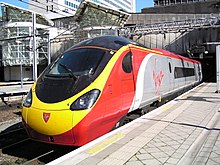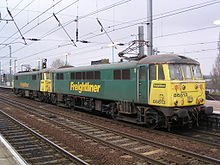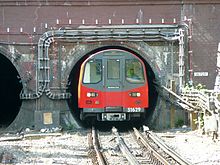Transport in the UK
The UK's transport network is well developed. The main road network, centered on London , Edinburgh and Belfast , is 46,894 km long and the motorway network, centered on Birmingham , Manchester and London, is 3496 km. In total there are over 388,000 km of paved roads. The network of the various private railway companies, on which 18,000 passenger trains and 1,000 freight trains run daily, is 16,878 km long (342 km of which in Northern Ireland ). Various large cities, particularly London, have well-developed suburban rail networks. The London Heathrow Airport has the largest number of passengers in Europe and the seventh largest worldwide. Over 558 million tonnes of goods were handled in British ports in the 2003/04 fiscal year.
railroad
- Main articles: Rail transport in Great Britain , Rail transport in Ireland
The UK rail network consists of two separate sub-networks, Northern Ireland and Great Britain . Since 1994, the latter is through the Euro tunnel with the European mainland connected. The Northern Irish network is linked to that in the Republic of Ireland .
Great Britain
The rail network in Great Britain is the oldest in the world. The structure is formed by the five main lines running radially from London, the West Coast Main Line , East Coast Main Line , Midland Main Line , Great Western Main Line and Great Eastern Main Line . These are supplemented by numerous regional lines and dense suburban networks in the metropolitan areas. The Channel Tunnel Rail Link is operationally separate from the rest of the rail network and built according to the same specifications as the TGV network in France.
The world's first passenger rail line was the Stockton and Darlington Railway , opened in 1825, and the Liverpool and Manchester Railway , opened in 1830, was the world's first railway line between two major cities. As a result, hundreds of railway companies were founded, which were consolidated into four companies in 1922 after numerous mergers. In 1948 the railways were nationalized, then the route network was reduced to less than half. In 1994 and 1995 the British Railways were split up into infrastructure, maintenance, rolling stock, passenger and freight companies, which were privatized in 1996 and 1997.
In Great Britain, the rail infrastructure (especially rails, stations, workshops and signals) is owned by the not-for-profit company Network Rail , which also maintains it. Network Rail succeeded the bankrupt private company Railtrack in 2002 . Passenger traffic is carried out by numerous railway companies . Most of them franchise certain services specified by the government and receive financial support in return. Freight transport is completely commercialized and the various operators do not receive any government subsidies. Most railway companies do not have their own rolling stock, but borrow them from three rolling stock companies.
The rail network in Great Britain comprises 16,536 km of standard gauge lines (1435 mm). Of this, 4,928 km are electrified and 12,591 km have double or multiple tracks. The top speed was 125 mph (200 km / h ) on the InterCity lines for decades . On the Channel Tunnel Rail Link , which connects London with the Eurotunnel, the Eurostar trains travel at up to 300 km / h.
Northern Ireland
In Northern Ireland, unlike Great Britain, the railways are not privatized. The state-owned company Northern Ireland Railways (NIR) owns the infrastructure and operates passenger services. The Northern Irish railway network is one of the few in Europe that does not handle freight traffic. In 1996 NIR merged with the two public bus companies Ulsterbus and Metro to form the translink transport company.
The Northern Irish rail network comprises 342 km of broad gauge (1600 mm) lines. Of these, 190 km are double or multi-lane.
Urban rail transport
Three British cities have subways and light rail systems . Best known is the London Underground in London, the oldest and longest underground railway in the world. The Docklands Light Railway is also located in London . The Glasgow Subway operates in the largest Scottish city, Glasgow , and the Tyne and Wear Metro operates in Newcastle upon Tyne and the surrounding area . Cities can also operate local rail networks through Passenger Transport Executives (a type of transport association ). Some networks, e.g. B. London Overground or Merseyrail , are routed like suburban trains through the city.
In the 19th and early 20th centuries, every major city had a tram . With the increase in motorized individual traffic, they were largely shut down and dismantled in the 1950s. In 1962 only the Blackpool tram remained. Since the beginning of the 1990s, individual new tram and light rail networks have been created:
- Manchester Metrolink in Greater Manchester
- Sheffield Supertram in Sheffield
- Midland Metro in Birmingham / Wolverhampton
- Tramlink in Croydon
- Nottingham Express Transit in Nottingham
Streets
- Main articles: Road system in Great Britain , Road system in Ireland , List of highways in Great Britain
Road network

The UK's road network is approximately 388,000 km. Around 3500 km of these are motorways that have been built since the 1950s. In addition to the motorways, there is also a dense network of four-lane, directionally separated highways (A roads) , on which all types of vehicles are permitted and which intersect with other roads. This type of road is also known as a dual carriageway and corresponds to the motorway-like roads in German-speaking countries. Multi-lane roads have so-called "U-Turns" (German: semicircle turn) or roundabouts (roundabouts) at regular intervals.
For the maintenance of the motorways and trunk roads in England which is Highway Agency in charge, a subordinate to the Ministry of Transport Authority. The local administrations are responsible for the rest of the road network in England. In Scotland the maintenance part of the road network to the responsibility of Transport Scotland , in Wales the Welsh Parliament and Northern Ireland of Roads Services (Department of the Ministry of Regional Development).
Toll roads are rare in the UK, but there are many toll bridges such as B. the Humber Bridge . 2003, the first toll motorway was opened, the Motorway M6 Toll , which in Birmingham the M6 motorway relieved. In some cities an inner city toll is payable (e.g. the London Congestion Charge ).
Since February 4, 2008, is also in the greater area of London low emission zone (Low Emission Zone - LEZ) was established. According to the supervisory authority Transport for London, it is the largest environmental zone in the world. From February 4, 2008 to January 2012, the emission ceilings will be gradually increased. However, no cars are affected, but rather smaller transport vehicles and buses and even trucks. Before one of these vehicles can enter the zone, it must be registered beforehand. If the vehicle does not meet emissions standards, a daily fee is payable. Unregistered vehicles risk a fine. Further information can be found on the website.
The maximum speed limit on motorways is 70 mph (113 km / h), up to 60 mph (97 km / h) outside of town and 30 mph (48 km / h) in town. Left-hand traffic in the UK .
Bus transport
Coach services operate on numerous intercity routes across the UK. National Express offers the largest service in England and Wales, while Megabus and Scottish Citylink also operate in Scotland . The municipalities were once responsible for urban and regional bus transport . Since the full privatization and deregulation in the 1990s, over 80% of the former bus companies owned by the "Big Five" (Big Five) . These are the private transport companies Arriva , First Group , Go-Ahead Group , National Express Group and Stagecoach Group . Bus transport in Northern Ireland is still state-owned and is handled by Translink .
shipping

Because of the island's nature of the United Kingdom, the waterway was the only way to enter or leave the state before commercial air traffic began and before the Eurotunnel was built. The only exception to this is the land border between Northern Ireland and the Republic of Ireland .
Ports
Around 95% of all goods reach the UK by ship (equivalent to 75% of the total value). The four largest ports in the country are:
- Felixstowe on the east coast - fourth largest port in Europe
- Tilbury near London
- Southampton on the south coast
- Teesport at Middlesbrough
There are numerous other sea and inland ports, the most important of which are:
Aberdeen , Avonmouth , Barry , Belfast , Bristol , Cardiff , Dover , Falmouth , Glasgow , Gloucester , Grangemouth , Harwich , Kingston upon Hull , Kirkwall , Leith , Liverpool , London , Manchester , Peterhead , Plymouth , Poole , Port Talbot , Portsmouth , Scapa Flow , Sullom Voe , Swansea and Tyne .
Merchant marine
For several centuries the United Kingdom owned the largest merchant marine in the world, but has since been overtaken by other states. There are 429 ships with over 1000 GRT (as of 2005, a total of 9,181,284 GRT). Of these, 18 were bulk carriers, 55 freighters, 48 chemical tankers, 134 container ships, 11 liquid gas tankers, 12 passenger ships, 64 passenger / cargo ships, 40 oil tankers, 19 refrigerated cargo carriers, 19 ro-ro ships and three vehicle carriers. There are also 446 ships that are registered in other countries and 202 ships with British licenses that are foreign owned.
Other shipping

Passenger ferries connect the UK with nearby countries such as France , Ireland , Belgium , the Netherlands , Denmark , but also Spain and Norway . There are major domestic routes between Scotland and Northern Ireland, between England and the Isle of Man, and from the south coast to the Isle of Wight and the Channel Islands . In addition, there are numerous ferry connections of local importance.
Inland shipping
See also Category: Canal in England
At the beginning of the industrial revolution , numerous inland canals were built in the United Kingdom , which were mainly used by so-called narrowboats , the dimensions and construction of which were adapted to the characteristics of the English canals. At the beginning of the 19th century, most of the transport services on the canals were made up of goods. The importance of the canals declined sharply after the first railways were built in the 1830s.
Today there are navigable inland waterways in Britain with a total length of 3,200 km. They are mostly used for recreational purposes. 620 km are still used commercially today.
air traffic
- See also list of UK airports
There are 471 airports and airfields in the UK, 334 of which have paved runways (as of 2004). The country's largest airport is London Heathrow , with the largest number of passengers in Europe and the sixth largest in the world. In 2018, the airport handled around 75 million passengers. Gatwick Airport and Manchester Airport follow in second and third place . Other major airports are London-Stansted , Birmingham International , Cardiff International , Glasgow International and Belfast International .
The largest British airline is British Airways , followed by bmi , easyJet and Virgin Atlantic Airways .
swell
This article contains information from the CIA World Factbook , which is in the public domain as a publication by a US government agency .
- ↑ Low emission zone website . Transport for London. Retrieved October 6, 2009.








